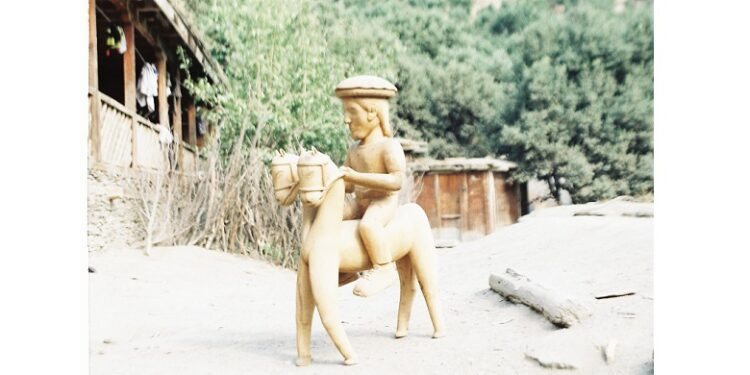
An artist has innovated the gandao without a turban or cap. The mouth of the figure has been hung open in awe. This reflects, according to the artist, the lost kingdom of the Kalash, who once used to rule over all of present-day Chitral. A gandao without headgear is a symbol of the loss of respect and power.
Zulfiqar Ali Kalhoro
The tradition of making wooden funerary statues of the ancestors, locally called a gandao, still continues in the three valleys of Birir, Rumbur and Bumburet in Kalash, Chitral. Today, it is not widely practiced as it was done in the past. A few families have recently made gandaos for their ancestors. Recently, Faizi Kalash has erected two gandaos of his father and uncle in the Brun village, Bumburet valley. In order to honor his father’s memory, the son erects a wooden statue, an image of the ancestor, i.e. gandao, which is placed over the grave of the deceased.
But today very few families follow this practice due to multiple reasons. There are very few woodcarvers amongst the Kalash who make the gandaos. Among these craftsmen, Yasir Kalash and Bhai Kalash of Brun village in Bumburet valley, and Rehmat Wali Kalash of Rumbur are quite prominent.
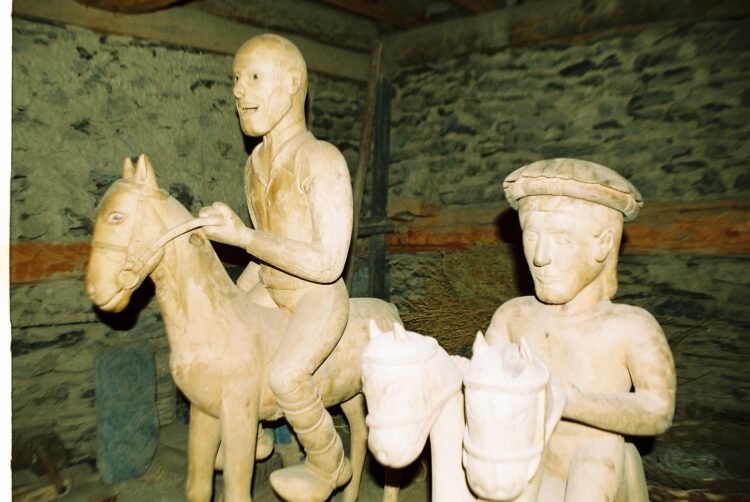
Rehmat Wali is particularly renowned for making impressive wooden statues. He lives in Kalashgram village in Rumbur valley, which was once home to many wooden statues and Kaundriks (triumphal posts). But today they do not exist and are preserved only in the memories of the people. Rehmat Wali believes that there were more than 40 gandaos located in different villages of the Rumbur valley, which were stolen by people to sell abroad. The most famous gandaos of Rumbur valley were those of Khush Beg, Amir, Achayak, and Mahamurat and his two sons – which were also taken away. The mounted gandaos of Khush Beg and Amir were also stolen. Due to frequent stealing, people have stopped making the gandaos. In the past, people used to go to Prasun and Basghal valleys of Nuristan in Afghanistan to make the gandao of their ancestors. Both valleys had celebrated woodcarvers. The father of Rehmat Wali also went to Prasun to learn the art of gandao-making.
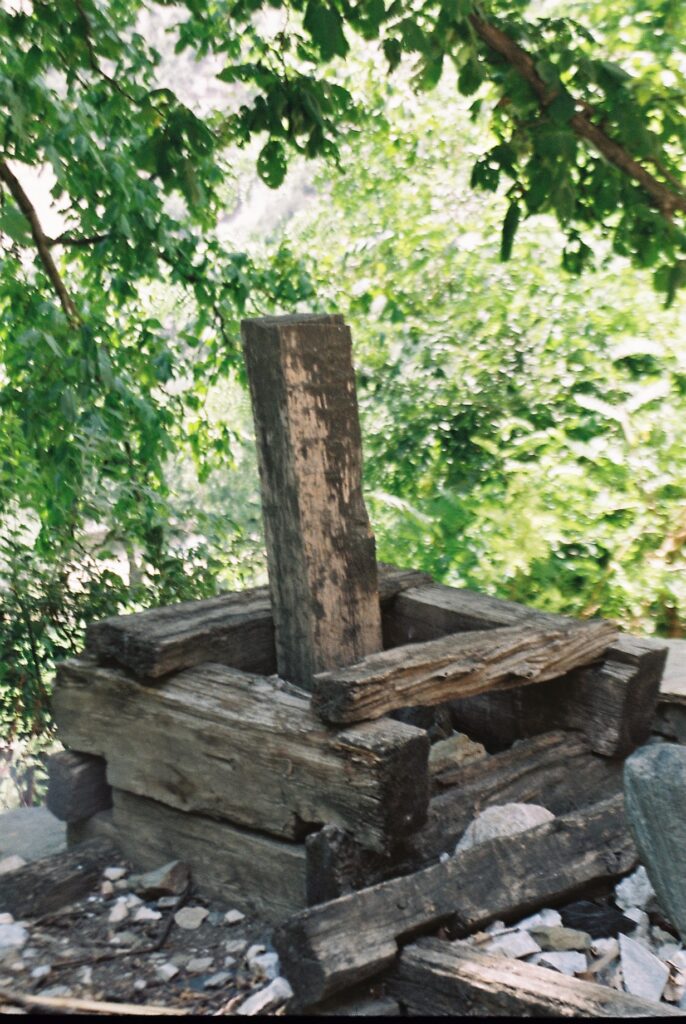
A handicapped artist, Rehmat Wali learned the art of making wooden statues from his father, who was also a very famous woodcarver. He makes gandaos for commercial as well as non-commercial purposes. Mostly, it is foreigners purchase and value his work. They do not pay much. The earned amount is, however, sufficient to meet his needs. He has made many gandaos or images of ancestors.
Rehmat Wali believes that there were more than 40 gandaos located in different villages of the Rumbur valley, which were stolen by people to sell abroad
One of the distinctive qualities of the artist is that he carves out the model from just one piece of wood, which is by and large difficult. Only the artists of the Prasun and Bashgal valleys had this specialty.
Rehmat Wali has brought some innovations to his work. Mostly, the mounted or seated gandaos were made to wear turbans, which symbolised power, bravery or influence that the deceased exerted over his community in the valley. However, Rehmat Wali has made a gandao of a horseman with a cap: i.e. the woolen cap that is still worn by the Kalasha people. The artist has rendered a folding into the cap in the front, with slits on either side – all of which indicates keen observations of his culture. The renderings are quite remarkable.
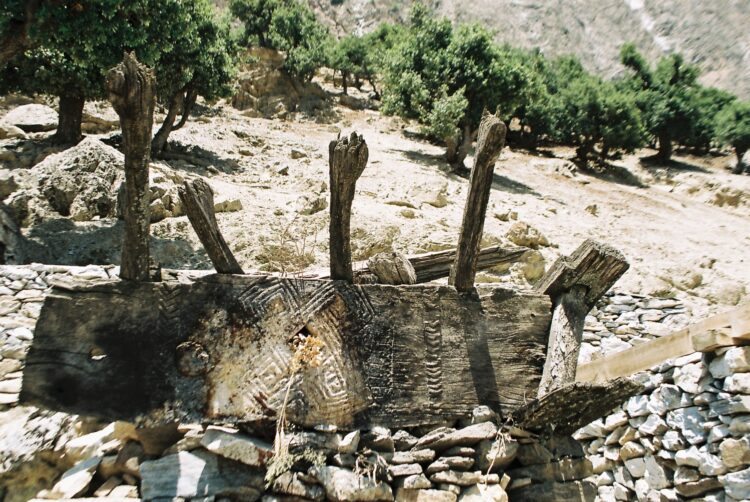
This figure features a horse with two heads. The depiction with two heads of the horse is a symbol of power in the culture of the Kalash. One can find depictions of the horse’s head on the many sanctuaries of the Kalasha people. The horse retains an important place in Kalash thought and imagination, although it is virtually impossible for the present-day Kalash to actually own horses, due to the scarcity of grass in the valleys. The presence of the divine is symbolised by the wooden heads of this revered animal in the sanctuaries of Sajigor, Mahandeo, Jestak and others. The sanctuary of the Mahandeo is called Malosh. These shrines are located in different villages of Bumburet valley. However, the most prominent is situated in Brun village. Mahandeo (great god) has a marked character as a virile warrior god, who protects crops, birds and hunting. He is, in fact, a protector of the Kalasha people, their villages and territory as a whole.
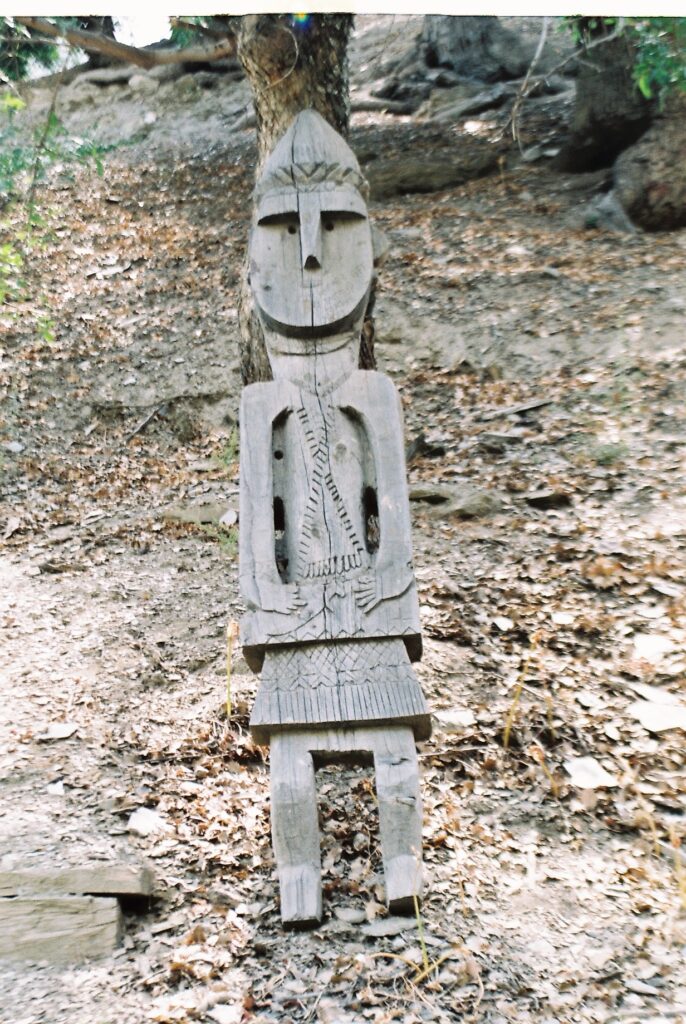
The Jastak han (village temple deity) has, on the other hand, a feminine personality. She is a protector of the home, the family, private life, pregnancy, birth, children, love, marriage, sickness etc. The Kalash people hold funeral ceremonies at the Jastak han. Soon as anyone dies in the village, the corpse is placed in a rough wooden coffin and brought to the temple.
Here, an innovation introduced by this artist is the gandao without a turban or cap. The mouth of the figure has been hung open in awe. This reflects, according to the artist, the lost kingdom of the Kalash, who once used to rule over all of present-day Chitral. A gandao without headgear is a symbol of the loss of respect and power.
At present, there is only one gandao of Pilin Beg which is located in Kalashgrum cemetery. Pilin Beg was the grandfather of Rehmat Wali.
The concerned authorities should extend support and official patronage to the vanishing gandao art in general and the art of Rehmat Wali in particular.
__________________
 Zulfiqar Ali Kalhoro is an anthropologist and author of 12 books including ‘Symbols in Stone: The Rock Art of Sindh’, ‘Perspectives on the art and architecture of Sindh’, ‘Memorial Stones: Tharparkar’ and ‘Archaeology, Religion and Art in Sindh’. He may be contacted at: zulfi04@hotmail.com
Zulfiqar Ali Kalhoro is an anthropologist and author of 12 books including ‘Symbols in Stone: The Rock Art of Sindh’, ‘Perspectives on the art and architecture of Sindh’, ‘Memorial Stones: Tharparkar’ and ‘Archaeology, Religion and Art in Sindh’. He may be contacted at: zulfi04@hotmail.com
Courtesy: The Friday Times Lahore